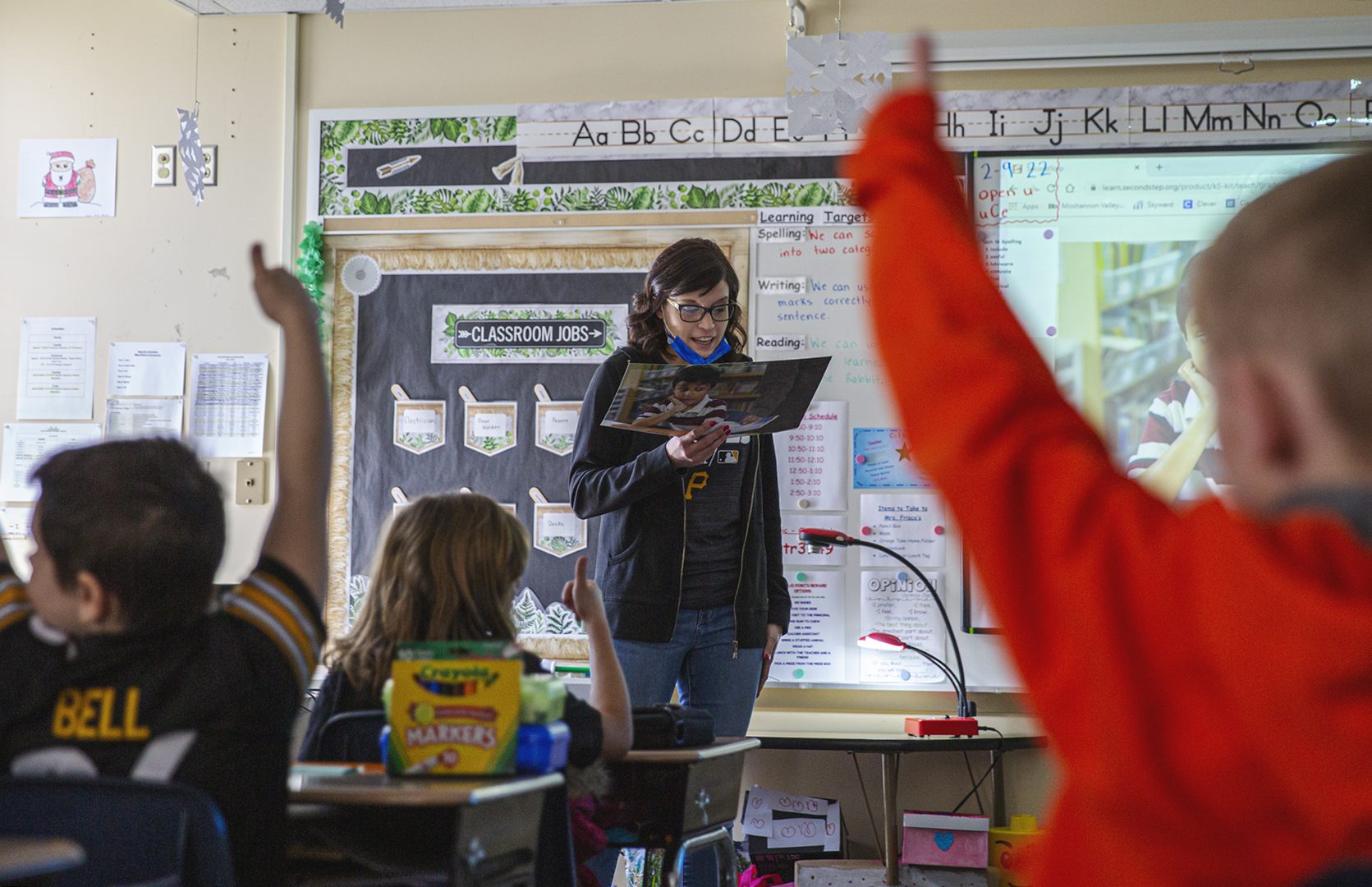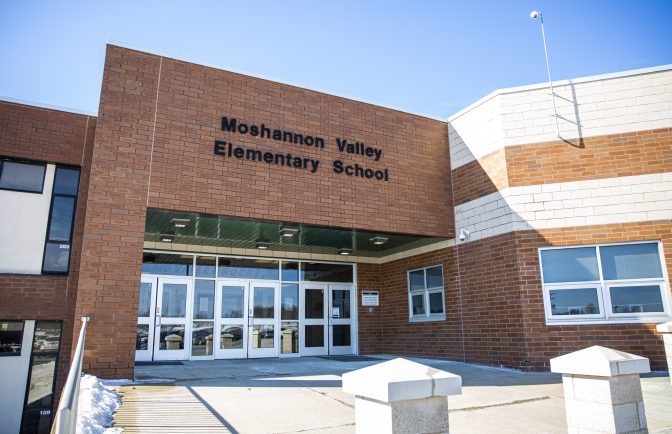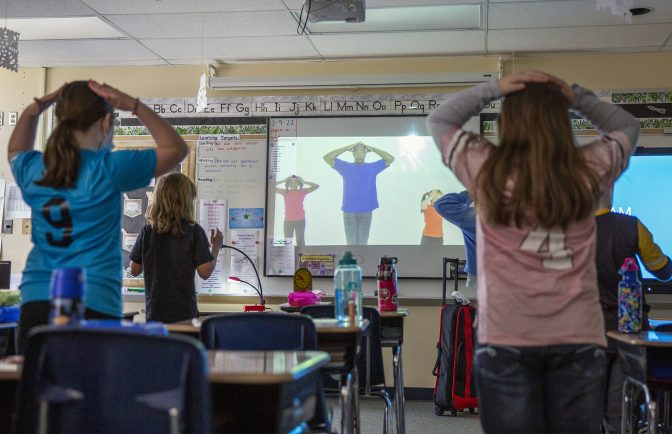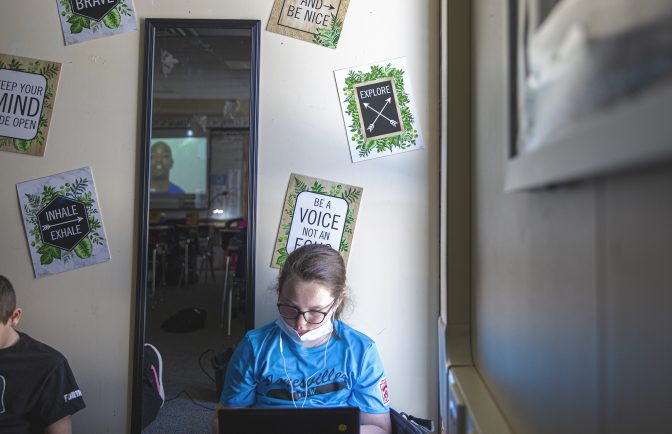
Every Wednesday, Rachel Welsh teaches her Moshannon Valley Elementary School class about emotions and self regulation skills.
Min Xian / WPSU

Every Wednesday, Rachel Welsh teaches her Moshannon Valley Elementary School class about emotions and self regulation skills.
Min Xian / WPSU

Min Xian / WPSU
Every Wednesday, Rachel Welsh teaches her Moshannon Valley Elementary School class about emotions and self regulation skills.
Even before the pandemic, John Zesiger knew his students needed more social and emotional support.
Zesiger is the superintendent of Moshannon Valley School District in rural Clearfield County, Pa., where more than half of its students come from economically disadvantaged backgrounds. He said many of them face stress and trauma at home.
“We have a lot of students who are residing with grandparents or other family members. We have a lot of single family homes. We have a lot of homes with an incarcerated parent or an addicted parent,” Zesiger said. “All of those things just continue to add up.”
He had hoped hiring a social worker would help – there’s state and federal COVID-19 relief money to pay for one. But filling the job opening hasn’t been easy.
The shortage of mental health professionals is nationwide. The American Academy of Child & Adolescent Psychiatry considers a ratio of 47 child and adolescent psychiatrists for every 100,000 children to be “sufficient.” It estimates, in reality, there are 14 child and adolescent psychiatrists per 100,000 kids.
“It’s been two years now we’ve advertised regularly through a contracted service,” Zesiger said. “There is such a great need for social workers across the state, that they kind of have their pick of where they go and what they make. Being a small rural district, we’re just not equipped to compete with some of those larger districts.”
In the absence of a licensed social worker, Moshannon Valley started asking teachers to spend more classroom time on something new: social-emotional learning.

Min Xian / WPSU
The pandemic has exacerbated the shortage of mental health professionals, especially in rural areas. The Moshannon Valley School District could not fill a social worker position for more than two years, even when state and federal governments would pick up the tab.
Social-emotional learning helps students manage big feelings
Every Wednesday, Rachel Welsh teaches her Moshannon Valley Elementary School class about emotions and self regulation skills – like taking a timeout or counting down when they feel overwhelmed.
During one recent lesson, upbeat music filled Welsh’s classroom. Her third-graders danced as they sang, “Stop and name your feeling. Calm down.”
When the music stopped, Welsh began her lesson. “Today you’ll learn more about feelings,” she told the class. “You’ll find out what happens in your brain and your body when you feel strong feelings, and how to notice the feelings.”

Min Xian / WPSU
Moshannon Valley Elementary School students spent classroom time learning about their emotions every Wednesday.
These lessons are designed to help students manage their feelings and extend empathy and kindness to those around them.
It’s never too early to teach about feelings
Social-emotional learning can also help with academics, because a child who is struggling emotionally isn’t necessarily ready to learn, said Jenn Christman of the National Association for Rural Mental Health.
“Sure, we can get the child to school. But how do we get the child to be able to be present, to be educated, to be available for the resources that are being taught to them throughout the course of the day?” Christman said.

Min Xian / WPSU
Moshannon Valley Elementary School student Lucy Fox does school work in the corner of her classroom featuring positive messages printed on the wall. School officials said instead of sending students to the counselor if they need a timeout, they can do so without leaving the classroom, minimizing learning loss.
As for when to start social-emotional learning, Christman said “the earlier the better.”
Melissa Elensky’s son, JJ, started social-emotional lessons at Moshannon Valley Elementary School when he was in first grade. He’s now in third grade, and Elensky said she’s seen him put those classroom lessons to good use.
“I heard him say, like, if he’s frustrated with something, like, ‘I need to take a belly breath.’ That is not something he got from our house, but I know for sure that that’s part of this curriculum,” she said.
As JJ gets older, Elensky said his social-emotional skills have been improving; she’s seen him resolve complex problems all on his own.
“It’s nice to see how it has built on the lower grade levels for him to carry those skills over,” Elensky said.
A trained professional for Moshannon Valley
After two years of looking, Moshannon Valley did finally hire a licensed social worker, who started in April. But the state and federal funding for the job won’t be around forever. Superintendent John Zesiger said the district is already working on making the social worker position a permanent item on its budget.
“We can’t lose [it],” he said.

A collection of interviews, photos, and music videos, featuring local musicians who have stopped by the WITF performance studio to share a little discussion and sound. Produced by WITF’s Joe Ulrich.
The days of journalism’s one-way street of simply producing stories for the public have long been over. Now, it’s time to find better ways to interact with you and ensure we meet your high standards of what a credible media organization should be.